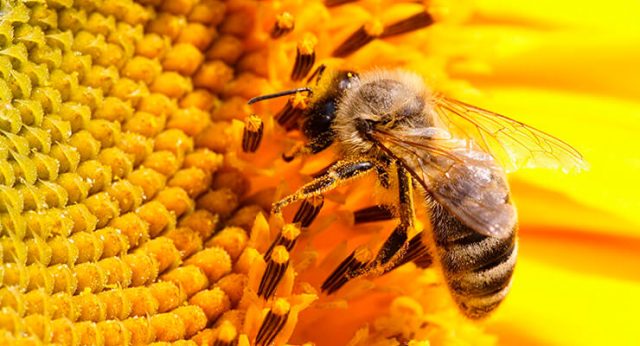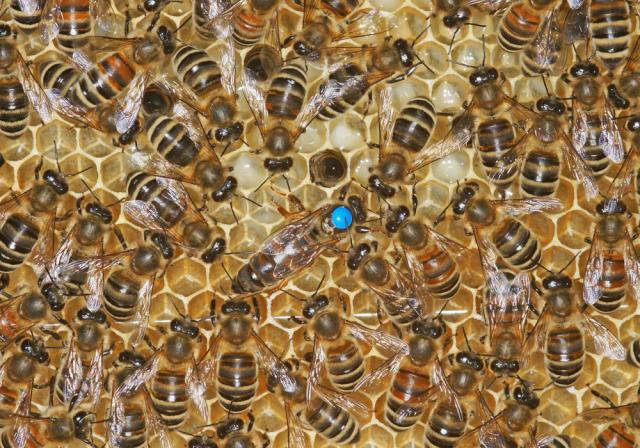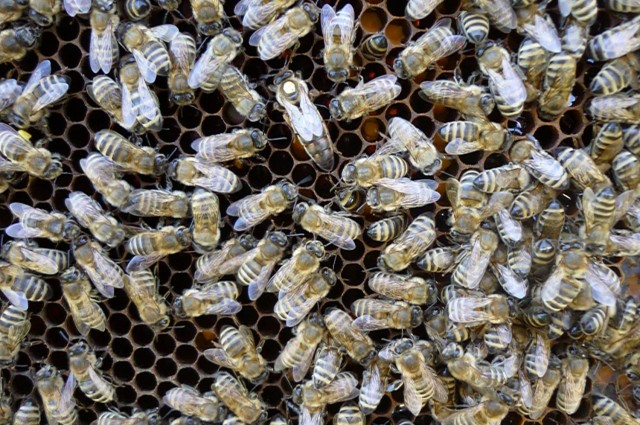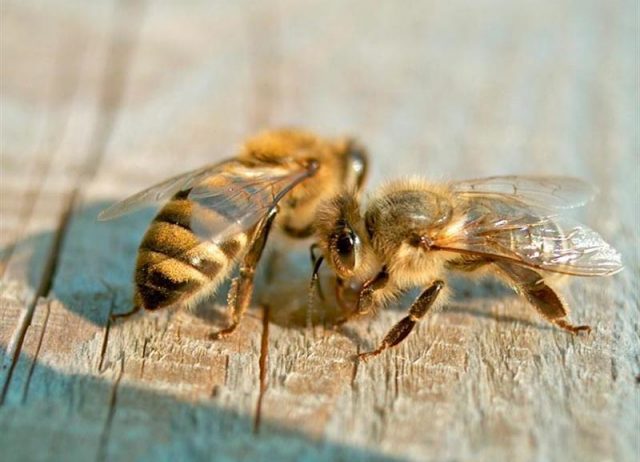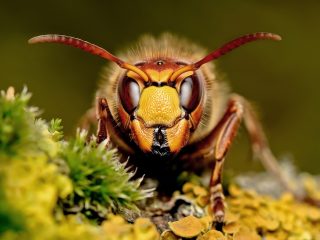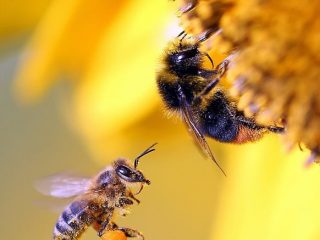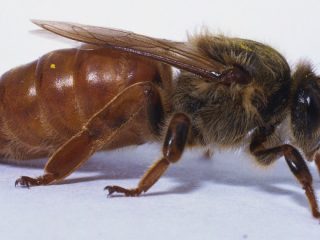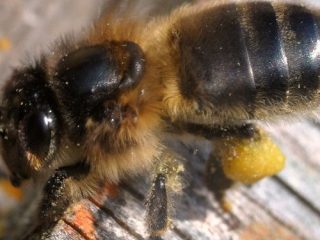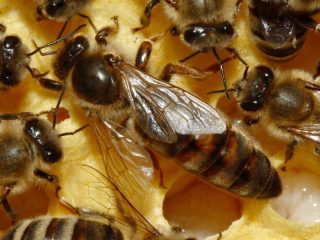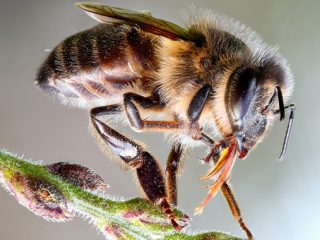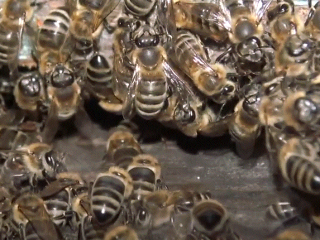Content
- 1 Description of the Karnika bee breed
- 2 Disease resistance
- 3 Recommended regions for breeding
- 4 Breed productivity
- 5 Advantages and disadvantages of the breed
- 6 Features of reproduction
- 7 Breeding Features
- 8 Content Tips
- 9 Comparison of several breeds
- 10 Conclusion
- 11 Reviews from beekeepers about Karnika bees
There are more than 20,000 breeds of bees across the globe, but only 25 of them are honeybees. In Russia they breed Central Russian, Ukrainian steppe, yellow and gray mountain Caucasian, Carpathian, Italian, carnika, buckfast, a Far Eastern breed of bees. Each of them has characteristic features unique to it and is adapted to certain climatic conditions. The result of honey collection, the health and growth of the bee colony, and the reduction of production costs depend on the correct choice of breed in a given area. Karnika is a popular variety in Europe with many positive qualities. The disadvantages of carnika bees are insignificant and do not detract from their advantages.
Karnika bee in the photo:
Description of the Karnika bee breed
The breed of carnika or krainka bees (Apismelliferacarnica Pollm) was developed at the end of the 19th century in the historical region of Slovenia - Krajne, by crossing the Cypriot drone and the Italian bee. Distributed in Eastern and Western Europe, popular in Russia. Within the breed, there are several main strains: Troyzek, Sklenar, Peschetz, Serbian, Polish, Lower Austrian, Hollesberg.
With some minor differences, they have characteristic features:
- large – weighing from 100 to 230 mg;
- silver-gray in color, thick-haired;
- the abdomen is pointed, the chitinous cover is dark in color;
- on the dorsal semirings there are signs of light-colored rims;
- a large number of holds on the rear wing;
- proboscis 6-7 mm long;
Some varieties are characterized by yellow stripes on the first 2-3 tergites. The color of the chitinous cover can also vary - it can be black, dark brown.
Description of the queen bee
Queens of the Karnika breed are almost twice the size of worker bees: a barren queen weighs 180 mg, a fertile queen weighs 250 mg. The abdomen is less shaggy, the color is dark brown with light brown stripes. The wings are almost twice as long as the body. Daily egg production is 1400-1200 pcs. with a total weight of 350 mg.
Describing the experience of breeding karnik queen bees in reviews, beekeepers claim that they are replaced quietly, without war, and the temporary coexistence of two queens is acceptable. A family usually lays 2 queen cells, this amount is enough for productive reproduction. At a temperature of + 5 °C, the queen bee can begin to turn black even in winter. The fertility of the queen bee carnika has a positive effect on the early spring honey harvest - the family is completely ready for it and has gained strength.
How do Karnika bees behave?
They are distinguished by a calm and peaceful character. The beekeeper can calmly inspect the nest - the bees do not show aggression, the queen continues to lay eggs, and the insects remain on the frame. Hardworking. They have a developed sense of smell and spatial orientation. They are prone to attack, but they protect their hive well from thieving bees. Roylivy, in the absence of a bribe, this property is enhanced - the beekeeper needs to take preventive measures. For this reason, they are unsuitable for nomadic apiaries.
Adapted to flying in mountainous areas, they can collect honey at an altitude of 1500 m. Cloudy and cool weather is not an obstacle to leaving the nest. When the main honey flow occurs, brood rearing is limited. Excellent builders - they begin to form honeycombs in early spring, even with a weak bribe. The honey is stored first in the brood part of the hive, then in the store. The honey signet is white and dry; carnika bees practically do not use propolis when building honeycombs. Insects require hives with vertical nesting extensions. Clean the hive yourself from wax moths and varroa mites.
How do they cope with wintering?
They begin to prepare for wintering early, after the end of the main summer season. If there is a lack of pollen, laying and brood rearing are limited. They winter in small families, consuming food sparingly. They do not require special conditions - they live in a hive with a wall thickness of 3.5-4 cm and a regular frame. By spring they come strong, with a minimum amount of death, with clean nests, and their families are rapidly expanding.The bee is characterized by high endurance and winter hardiness. If the frost is stronger - 20 ˚С, the hives need to be insulated. 20-25 kg of food should be stored before the first flights for nectar.
Disease resistance
Karnika bees have high immunity to most diseases and are genetically resistant to honeydew toxicosis. In the case of a cold, long winter, insects are susceptible to nosemotosis. They are not susceptible to acarapidosis and paralysis. The brood and queen bee also rarely get sick.
Recommended regions for breeding
Krainki are popular among beekeepers in Central Europe, Austria, Romania, the Czech Republic, Slovakia, Germany and Switzerland. Karnika bees are adapted to live in regions with cold winters, short springs and hot summers.
Breed productivity
Karnika bees are hardworking and are able to work on any bribe. Thanks to their long proboscis, they are able to collect nectar with low sugar content. They easily find the best source of nectar and switch to it. Works well on red clover. Honey productivity is 1.5 times higher than that of other breeds. Better than other breeds, they use early honey collection. Under good weather conditions, the initial productivity is within 30 kg/ha. During the research, it was noticed that Kraynkas collect honey worse in places where the food supply is represented only by wild plants. They fly to work 20-30 minutes earlier than other types. They are good in areas where winter rapeseed and clover are grown - they provide high-quality early honey harvest.They collect nectar and pollen from fruit bushes and trees and pollinate them.
Advantages and disadvantages of the breed
The popularity of the Karnika bee breed ensures its calmness and lack of irritability. The advantages also include the following factors:
- high honey productivity;
- exceptional hard work;
- economy in feed consumption;
- weather changes do not affect productivity;
- the honeycombs are always white and clean;
- easy to transport;
- good adaptability;
- high fertility;
- rapid development of brood;
- good coordination;
- strong immunity;
- produce large amounts of royal jelly;
- high wax production.
The Karnika breed also has some disadvantages:
- swarming with low honey flow;
- Karnika bees practically do not produce propolis;
- genetic instability;
- restriction of the uterus in scarlet;
- brood randomly fills several frames, which creates inconvenience for the beekeeper;
- high price;
- late blackening in the warm autumn, which leads to wear and tear of the bees and excessive consumption of food.
Having tried to work with bees of the Karnika breed, beekeepers willingly master its breeding.
Features of reproduction
Karnika bees are characterized by intensive spring development, they quickly increase the strength of colonies and work on early honey plants. In the event of a return spring cold snap, they do not reduce the rate of brood rearing, using even scarce sources of nectar and pollen. To do this, they fly out of the hive even at a temperature of + 10 ˚С.
The family loses many adult flying bees; soon they are replaced by a sufficient number of young individuals.In the case of a harsh and long winter, reproduction may begin late, and by the beginning of the main honey flow, the strength of the swarm will be low. If the queen stops receiving pollen, she stops producing brood. For its proper and healthy development, the temperature in the hive should be within + 32-35 ˚С.
Breeding Features
In reviews of karnika bees, beekeepers point out their unpretentiousness and low purchase and maintenance costs, which more than pay for themselves in a short time.
Bee packages with the carnika family are purchased in special stores. The kit includes:
- 3 dadan frames with larvae and 1 covering frame;
- Karnika bee family;
- queen bee under 1 year of age with a mark on the back;
- food – kandi flatbread weighing 1.5 kg;
- water with a special, insect-friendly drinking device;
- package.
In March-May, carnika bee colonies develop rapidly, the highest peak being June-July. They create large families; the nest can occupy up to 3-4 buildings.
Content Tips
Before purchasing Karnika bees, you should find out which strain is best suited for a given region. Some are good for early spring bribes, others - for summer ones. The productivity of the family will increase significantly if the Krajina queen is kept together with drones of the Italian breed. The apiary can be kept on both flat and relief terrain. Periodically, you need to invite a veterinarian to examine the insects. Suitable for nomadic apiaries - they easily settle into a new place and do not fly into other people's hives.
It is important to provide the bees with water to save their energy. In hot weather, the ventilation holes in the hive should be opened.For productive beekeeping, karnik strains require maintaining the purity of the breed; when crossed with other species (even intrabreed strains), they lead to loss of breeding qualities.
Comparison of several breeds
When choosing a bee breed for a given area, a beekeeper needs to take into account many factors - adaptability to climatic conditions, queen fertility, immunity, viciousness, and playfulness. Each breed prefers a certain range of plants for honey collection - this must be taken into account when analyzing the honey plants growing around. The Central Russian bee tolerates the long, harsh winter better than anyone else, but is aggressive and effective in the abundant short harvest. Focused on one type of flowering plants - most of all intended for the production of monofloral honey. Caucasian bees, on the contrary, easily switch from one honey plant to another and work well on weak bribes.
Which is better: karnika or karpatka
Beekeepers cannot decide which breed of the two is better. With many similar characteristics, Karnika bees demonstrate a number of advantages:
- higher productivity;
- work at low temperatures and during heat, in cloudy weather and even during light rain;
- protect the hive from wax moths, keep it clean;
- when carrying out the necessary measures, they easily come out of the swarm state;
Some lines of the Karnika bee breed have a hard time withstanding wintering, emerging from it very weakened, developing poorly, working slowly, in which they are inferior to the Carpathian bees. Living in one place for 5-6 years, krains can become extremely playful. Carpathian moths are more prone to theft and do not pay attention to wax moths. If a colony begins to swarm, it is very difficult to bring it into working condition.
Which is better: carnica or buckfast
Buckfast is also characterized by high honey productivity, good immunity, economy and cleanliness. Not aggressive and not roaming. Karniks are inferior in frost resistance; they begin to fly around with the onset of warm weather, but they work better in humid weather. The queen fills the combs with brood in a continuous order and does not move on to other frames until one is completely filled. Buckfast bees, like carnika bees, need to expand their nest when breeding. It is convenient for the beekeeper to work with them - the honey is placed at the top of the nest or on the side. When choosing between buckfast or carnika breeds, you should take into account climatic conditions and economic factors - the former are more expensive.
Conclusion
The disadvantages of carnika bees are known in comparison with other breeds under similar conditions. The breed's weaknesses can be partly controlled (swarming, genetic instability), but otherwise beekeepers accept them and adapt. Reviews and comments about karnik bees are dominated by positive assessments; honey productivity, endurance, high immunity, calmness and friendliness come to the fore.
